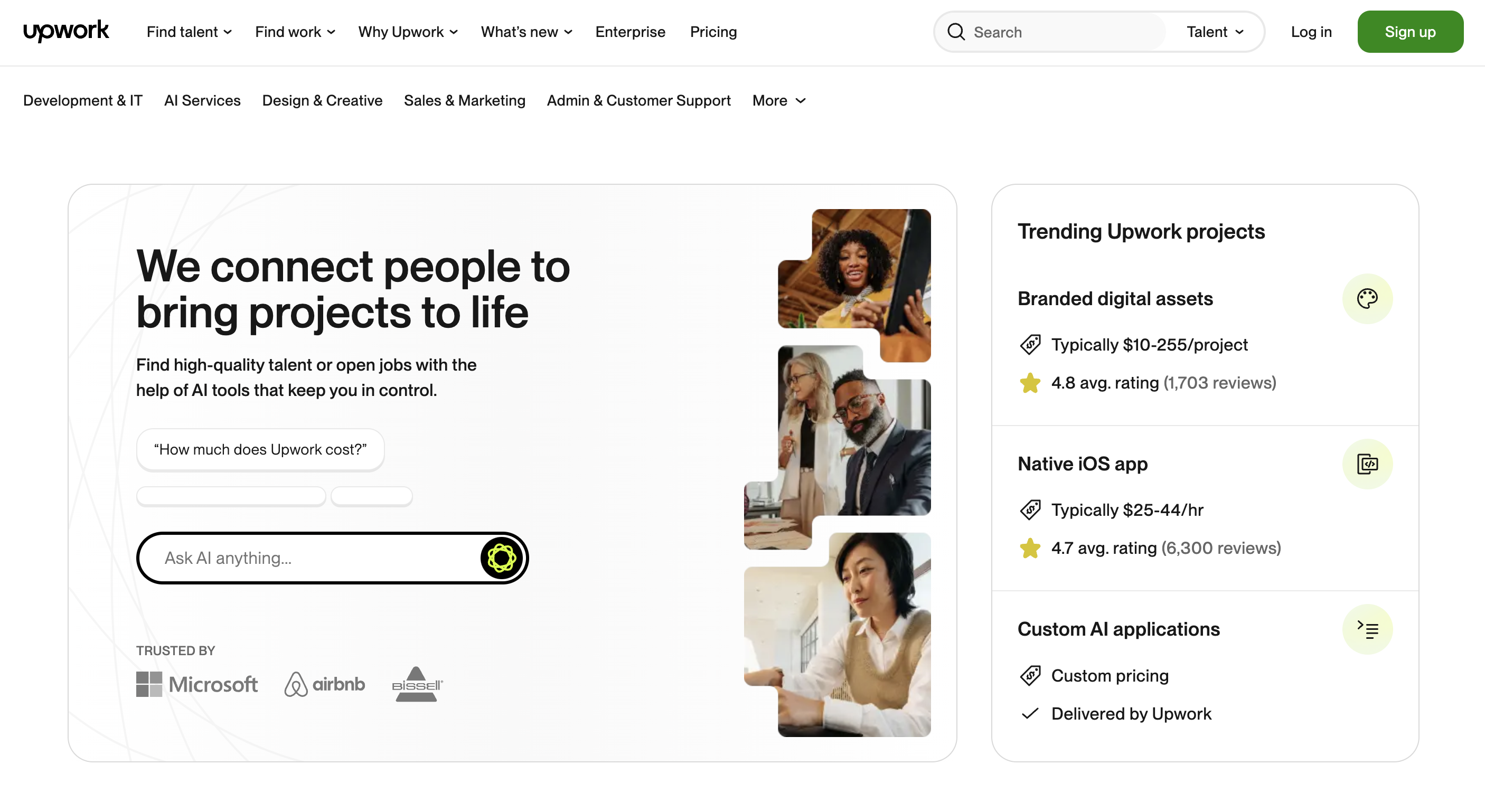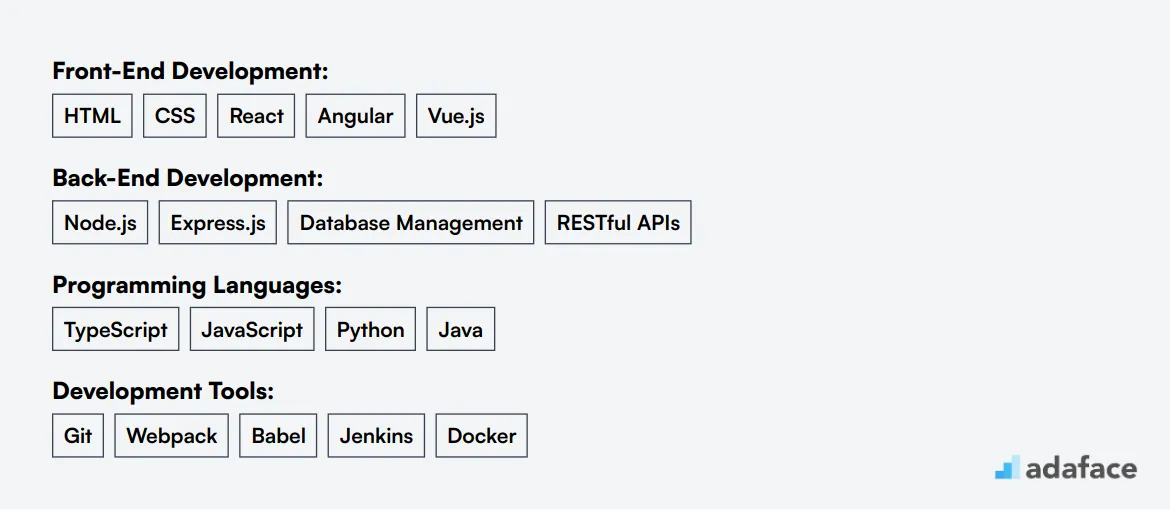Hiring a TypeScript developer can be a challenging task for recruiters and hiring managers. Many companies struggle to find candidates with the right mix of technical skills and practical experience. The key is to understand the specific requirements of your project and align them with the developer's expertise in TypeScript, JavaScript, and related technologies.
This comprehensive guide will walk you through the process of hiring a TypeScript developer, from defining the role to conducting effective interviews. We'll cover essential skills to look for, where to find top talent, and how to assess candidates using proven techniques.
Table of contents
Hiring process for TypeScript Developer role
The hiring process for a TypeScript Developer can typically take around 4-6 weeks. It's important to follow a structured approach to ensure you attract the right candidates efficiently.
- Craft a detailed job description: Begin by creating a precise job description that outlines the skills and responsibilities required. This will help in attracting suitable applicants.
- Resume screening: Expect to receive applications within the first week. Shortlist candidates based on their experience and familiarity with TypeScript.
- Skill assessment: Next, conduct skill assessments. You can utilize coding tests or case studies, which should take about a week to evaluate.
- Interviews: Schedule interviews with the shortlisted candidates. Focus on both technical skills and cultural fit during these discussions.
- Offer stage: Finally, extend an offer to your chosen candidate, and be prepared for negotiations if necessary.
In summary, this process generally spans 4-6 weeks, depending on how quickly you move through each stage. In the following sections, we'll explore each step in greater detail, providing resources and checklists to streamline your hiring efforts.
Skills and qualifications to look for in a TypeScript Developer
When hiring a TypeScript Developer, it's easy to get caught up in the specific technologies and tools. However, it's important to remember that a good candidate profile balances both required and preferred skills. While TypeScript proficiency is a must, some other skills might be nice-to-haves depending on your company's tech stack and current projects.
Ensure that you clearly differentiate between what's required and what's preferred for the role. For instance, while experience with front-end frameworks like React or Angular is typically necessary, skills like backend development with Node.js might be beneficial but not mandatory. If you're unsure where to start, our interview questions could help you assess candidates more effectively.
| Required skills and qualifications | Preferred skills and qualifications |
|---|---|
| Proficiency in TypeScript and JavaScript | Experience with backend development, preferably Node.js |
| Strong understanding of front-end technologies, such as HTML and CSS | Familiarity with additional programming languages, such as Python or Java |
| Experience working with common front-end development frameworks like React, Angular, or Vue.js | Experience with DevOps practices and CI/CD tools |
| Familiarity with RESTful services and APIs | Understanding of agile methodologies and frameworks |
| Experience using version control systems, such as Git | Knowledge of UI/UX design principles |
Top Platforms to Source TypeScript Developers
Now that you have a well-crafted job description, it's time to cast your net and find the right TypeScript talent. Job listing sites are your go-to resource for sourcing candidates. Let's explore some of the best platforms to post your TypeScript developer position and attract qualified applicants.
LinkedIn Jobs
Ideal for finding full-time TypeScript developers. Large user base and professional network make it suitable for attracting experienced candidates.

Indeed
Widely used job board for posting full-time TypeScript developer positions. Offers a large pool of candidates and easy application process.

Upwork
Excellent for hiring freelance TypeScript developers. Offers a wide range of skilled professionals for short-term or project-based work.

Beyond these mainstream options, there are specialized platforms catering to specific hiring needs. Remote.co and We Work Remotely are excellent for finding TypeScript developers open to remote work arrangements. Dice and Stack Overflow Jobs focus on tech-specific roles, while AngelList is ideal for startups looking to hire innovative TypeScript talent. Each platform offers unique benefits, so consider your specific requirements when choosing where to post your job listing.
Keywords to Look for in TypeScript Developer Resumes
Resume screening is a key step in finding the right TypeScript developer. It helps you quickly identify candidates with the most relevant skills and experience before moving to interviews.

When manually screening resumes, focus on primary keywords like TypeScript, JavaScript, and front-end frameworks (React, Angular, Vue.js). Look for experience with HTML, CSS, RESTful APIs, and version control systems like Git. These skills are essential for TypeScript developers and can help you shortlist promising candidates.
AI-powered tools can streamline the resume screening process. You can use ChatGPT or Claude with a custom prompt to analyze resumes based on your specific requirements. This approach can save time and ensure consistent evaluation across all applications.
Here's a sample prompt for AI-assisted resume screening:
TASK: Screen resumes for TypeScript developer role
INPUT: Resumes
OUTPUT: For each resume, provide:
- Email id
- Name
- Matching keywords
- Score (out of 10 based on keywords matched)
- Recommendation
- Shortlist (Yes, No, or Maybe)
RULES:
- If unsure about a candidate's fit, mark as Maybe
- Keep recommendations concise
KEYWORDS:
- TypeScript, JavaScript
- Front-end frameworks (React, Angular, Vue.js)
- HTML, CSS
- RESTful APIs
- Git
- Node.js (preferred)
- UI/UX design principles (preferred)
Using this prompt with AI can help you efficiently screen candidates and identify the most promising TypeScript developers for your team.
Which skills tests should you use to assess TypeScript Developers?
Skills tests play a key role in evaluating a candidate's ability to work with TypeScript. They offer a practical way to gauge their technical know-how and problem-solving skills, ensuring they can handle real-world projects. Here are some recommended tests to assess your TypeScript developer candidates:
TypeScript Online Test helps determine a candidate's competence in using TypeScript for developing large-scale applications. This test highlights their understanding of TypeScript's unique features and how they leverage them over plain JavaScript.
Angular TypeScript Test evaluates a developer's ability to use Angular with TypeScript. It is ideal for understanding their skill in building dynamic single-page applications and utilizing Angular's framework features.
For a more comprehensive view of front-end skills, consider the Front-end Developer Test. This test assesses knowledge of essential web technologies like HTML, CSS, and JavaScript, which are often used alongside TypeScript.
If your project involves both front-end and back-end tasks, the Full Stack Developer Test may be suitable. It ensures candidates have the necessary skills across various technologies, including TypeScript, to handle different project layers.
Lastly, the Coding Debugging Test helps measure a candidate's aptitude for identifying and resolving code issues. Effective debugging is a critical skill for TypeScript developers, ensuring the delivery of high-quality applications.
Structuring Technical Interviews for TypeScript Developers
After candidates pass the initial TypeScript skills tests, it's time for technical interviews to assess their practical abilities. While skills tests help filter out unqualified applicants, technical interviews are key to identifying the best fit for your team. Let's look at some sample interview questions to help you evaluate TypeScript developers effectively.
Consider asking: 1) 'How does TypeScript differ from JavaScript?' 2) 'Explain the concept of type inference in TypeScript.' 3) 'What are generics in TypeScript and when would you use them?' 4) 'How do you handle asynchronous operations in TypeScript?' 5) 'Can you describe a challenging TypeScript project you've worked on?' These questions help assess the candidate's understanding of TypeScript's core concepts, their problem-solving skills, and real-world experience with the language.
What's the difference between a Frontend TypeScript Developer and a Backend TypeScript Developer?
Many people confuse frontend and backend TypeScript developers due to their shared programming language. However, these roles have distinct responsibilities and focus areas in web development.
Frontend TypeScript developers primarily work on the client-side of applications. They create user interfaces using frameworks like React, Angular, or Vue.js. Their main goal is to enhance user experience and ensure smooth interactions with the application.
Backend TypeScript developers, on the other hand, focus on server-side logic and data management. They work with technologies like Node.js, Express, and NestJS to build robust server architectures. These developers are responsible for designing and implementing APIs, managing databases, and ensuring server performance and scalability.
Key differences include:
- Database knowledge: Frontend developers typically have basic database skills, while backend developers possess advanced knowledge for efficient data management.
- API handling: Frontend developers mainly consume APIs, whereas backend developers design and build them.
- Performance optimization: Frontend developers focus on client-side rendering and caching, while backend developers work on server optimization and scalability.
- Security concerns: Frontend developers deal with XSS and CSRF, while backend developers handle authentication, authorization, and data protection.
Understanding these differences is crucial for recruiters to match the right TypeScript developer to specific project needs.
| Frontend TypeScript Developer | Backend TypeScript Developer | |
|---|---|---|
| Primary Focus | User Interface and Experience | Server-side Logic and Data Management |
| Key Technologies | React, Angular, Vue.js | Node.js, Express, NestJS |
| Database Knowledge | Basic | Advanced |
| API Experience | Consuming APIs | Designing and Building APIs |
| Performance Optimization | Client-side Rendering and Caching | Server Optimization and Scalability |
| Testing Focus | Unit and Integration Tests | API and Load Testing |
| Security Concerns | XSS, CSRF | Authentication, Authorization, Data Protection |
| Deployment Knowledge | Static Hosting, CDNs | Server Management, Containerization |
Hire the Best TypeScript Developers
In this guide, we've journeyed through the process of hiring a TypeScript Developer, covering critical skills and qualifications, sourcing platforms, resume keywords, and more. We explored structuring technical interviews and understanding the nuances between frontend and backend TypeScript developers.
The key takeaway is to focus on creating precise job descriptions and utilizing skill assessments to streamline your hiring process. Incorporating assessments like the TypeScript Online Test can help you gauge the candidates' capabilities effectively. This ensures you bring in the right talent to meet your project's specific needs.
TypeScript Online Test
FAQs
Key skills for a TypeScript developer include strong TypeScript and JavaScript knowledge, familiarity with popular frameworks like Angular or React, experience with Node.js, understanding of OOP principles, and proficiency in version control systems like Git.
You can assess a TypeScript developer's skills through online coding tests, technical interviews with practical coding challenges, and reviewing their past projects or contributions to open-source TypeScript projects.
Good sources for finding TypeScript developers include tech job boards, LinkedIn, GitHub, Stack Overflow, TypeScript-specific forums, tech meetups, and referrals from other developers in your network.
A good TypeScript developer job description should include required technical skills, experience level, project responsibilities, team structure, and any specific frameworks or tools used in your development environment.
Structure the interview to include discussions about past projects, technical questions on TypeScript concepts, a live coding exercise, and questions about problem-solving approaches. Consider using pair programming exercises to assess collaboration skills.
Frontend TypeScript developers should have strong skills in UI frameworks like React or Angular, while backend developers need expertise in server-side technologies like Node.js. Tailor your assessment to focus on the specific domain (frontend or backend) based on your project needs.
Besides technical skills, assess the candidate's communication abilities, teamwork experience, and problem-solving approach. Consider including team members in the interview process and discuss the candidate's experience with your development methodologies and tools.

40 min skill tests.
No trick questions.
Accurate shortlisting.
We make it easy for you to find the best candidates in your pipeline with a 40 min skills test.
Try for freeRelated posts
Free resources



